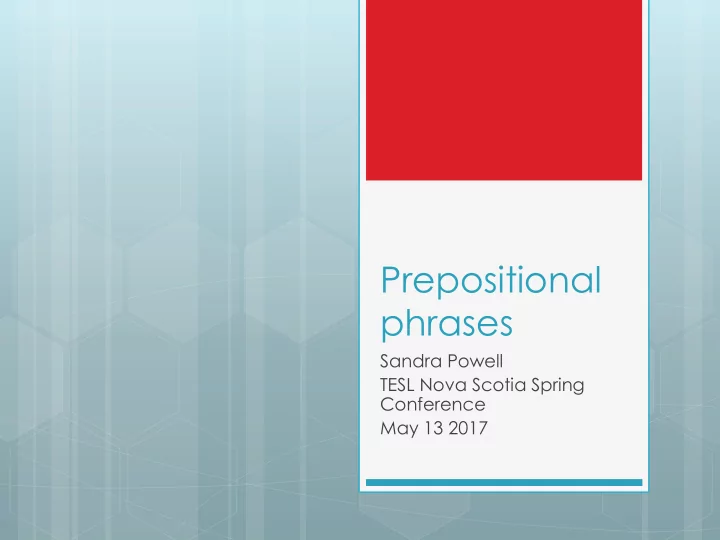

Prepositional phrases Sandra Powell TESL Nova Scotia Spring Conference May 13 2017
What are prepositions and how are they used in English? Function: to link NOUN Unvarying. We never add PHRASES up with other endings or change the grammatical units form of a preposition. Closed class. English is not Examples of adding new prepositions prepositional phrases : (though occasionally an in the morning for a very good reason existing word adds with a hammer and nails function as a preposition) into a large bag The most common over all the objections prepositions are very short words (of, for, in, on, at)
Why do teachers and learners dread grammar lessons on prepositions? “Prepositions” or “prepositional phrases” is the wrong topic for a lesson. Would you try to teach a grammar lesson on “verbs” or “nouns’? Choosing the right preposition: English has a lot of prepositions (compared to many other languages) Meanings of prepositions: Subtle, hard to explain, lots of idiomaticity
Lexicogrammatical continuum It’s grammar if… It’s vocabulary if… Pattern that we use in Item that we combining and associate with a grouping word meaning parts/words/phrases We learn vocabulary Rule that we can items one by one . apply in many sentences/utterances
Prepositions and prepositional phrases: Grammar or vocabulary? Pattern and rule, or item-by-item learning?
This exercise doesn’t contextualize prep. use and doesn’t help learners associate a meaning with a prep. (It can raise awareness but is not very useful for LEARNING.)
This exercise works well after learners read a passage, to focus attention on prep. usage that may otherwise pass unnoticed. However, it doesn’t associate a meaning with a preposition. No patterns.
Long list of left- collocating adjective-prep and verb-prep combinations. Alphabetical order: doesn’t help learners associate a meaning with a preposition: better to group items with similar prep. meanings.
Meaning: (spatial) Used to F show SOURCE of a movement R O A butterfly emerging FROM a cocoon. M
Meaning: (extended) The F source is a bad thing to be avoided! Separation from R source O M We need an umbrella to a protect us from the rain s o u r c e
Let’s generate some examples The OUCH exercise: Your health and safety: How many ways can you What can you do to prevent complete these phrases: accidents from happening ? What do you do to keep from Suffer from…. getting sick? Be in pain from… What dangers in our world Die from…. worry you? What do you do to Recover from…. protect yourself from those dangers? Think of some rules or laws that Give advice: what can we have in order to protect us you do to help someone from danger or harm. What is who is suffering from these the rule, and what is its problems? purpose?
Let’s generate some examples I n your town, what is 1. Cars: there are so many kinds of cars! Cars for different there (activities, services, kinds of people, and cars for places, programs) for different uses. List 5 phrases: a families? For singles? For car for….. How is this car young people? For specially suited for this group or seniors? For immigrants? this use? 2. Shampoo, deodorant, shavers and shaving cream, What groups are well cologne: what do you think served? What groups about different types for men need more attention? and for women? How about What do they need? clothes for men and clothes for Describe what you’d like women …. How are they for those groups. different?
W I T H I see a woman with a dog. I see a man with black shoes. I see a park with trees and flowers Why does it sound strange to say ‘I see a man with trees and flowers’?
(Noun 1 ) + with (Noun 2) W The relationship: I (Noun 1) HAS (Noun 2) A woman with a dog T A hot dog with mustard and relish H A house with 3 bedrooms That guy with the beautiful voice Sometimes, (Noun 2) IS PART OF (Noun 1) A notebook with a blue cover A woman with blue eyes Stories with happy endings
Let’s generate some examples List as many as you can think of: Subway sandwich: What 1. do you want with your sandwich? Order from your What can you do 1. with a pencil? classmates: I want a sandwich with….. What can you do 2. with your foot? Your ideal living space: 2. What can you do Interview your partners and 3. with your phone? complete the sentence: Choose another thing (Name) wants a and challenge your (adjective) place with classmates to think what (noun) and (noun) in/on/at they can do with it. (place)
Handouts and Powerpoint will be posted on teslns.com within the next few weeks. Sandra Powell
Recommend
More recommend